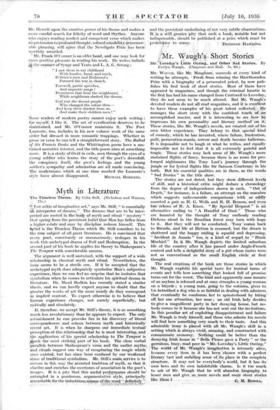Myth in Literature
ft,„..i.Tim critic of imaginative art," says Mr. Still, " is essentially A interpreter of dreams." The dreams that are to-tie inter- preted are rooted in therbiitty,Lof myth and ritual " mystery " that spring from the persistent pe,lief that Man has fallen from a higher estate and may by discipline redeem himself. This *lief is the Timeless Theme •which Mr. Still -considers to be the true subject of all great literature. He is convinced that every pOet, consciously or unconsciously, reshapes in his work this archetypal drama of Fall and Redemption. In the second part of his book he applies his theory to Shakespeare's The Tempest with considerable success.
The argument is well sustained, with the support of a wide scholarship in classical myth and ritual. Nevertheless, the issue seems to be a sterile one. If it be accepted that the archetypal myth does adequately symbolise Man's ;Objective experience, then we can feel no surprise that he imitates that symbolism when he comes to articulate his spiritual drama in literature. Dr. Maud Bodkin has recently stated a similar thesis, and we can _hardly expect anyone to doubt that the greater the works of art the more nearly do they correspond in implicit content. To expect otherwise is to believe that lininan experience changes, not merely superficially, but radically and absolutely.
If, therefore, we accept Mr. Still's theory, it is as something Much less revolutionary than he appears to expect. The only astonishment he can provoke lies in his discovery of literal correspondences and echoes between myth and historically. recent art. It is when he sharpens our immediate textual perception of this relationship that he is most interesting, and the application. of his special scholarship to The Tempest is siuch the most striking part of his book. The close verbal :parallels between Shakespeare's verse and the earlier myths! and rituals suggest one way of recapturing the magic which once existed, but has since been confused by our 'Weakened sense of traditional symbolism. Mr. Still's main, service is to restore in this way the accreted tradition of myth, so that it clarifies and enriches the oyertones of assoeintion ill the poet's images. It is a pity that this useful. perkirmance should be entangled in a ponderous, argumentative style, principally- remarkable for the industrious,misuse of the word " definite0 " and the persistent underlining of not very subtle observations. greater:pity- that such a book, notable but not indispensable, should be published at a price which must be










































 Previous page
Previous page